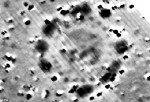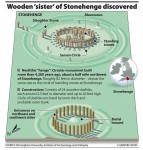 Okay so it’s not new, and it’s not really even a henge anymore so much as the ditches and postholes therefrom, but archaeologists are still lauding it as the most exciting find on the Salisbury Plain in 50 years. All kinds of smaller finds have been made during that time — from graves and attendant goods to a smaller wood circle — but this could be a major ceremonial monument.
Okay so it’s not new, and it’s not really even a henge anymore so much as the ditches and postholes therefrom, but archaeologists are still lauding it as the most exciting find on the Salisbury Plain in 50 years. All kinds of smaller finds have been made during that time — from graves and attendant goods to a smaller wood circle — but this could be a major ceremonial monument.
Note of caution: We don’t know yet exactly what it is, though. Right now all we see are images of holes, basically.
Images show it has two entrances on the north-east and south-west sides and inside the circle is a burial mound on top which appeared much later, Professor Gaffney said.
“You seem to have a large-ditched feature, but it seems to be made of individual scoops rather than just a straight trench,” he said.
“When we looked a bit more closely, we then realised there was a ring of pits about a metre wide going all the way around the edge.
“When you see that as an archaeologist, you just looked at it and thought, ‘that’s a henge monument’ – it’s a timber equivalent to Stonehenge.
“From the general shape, we would guess it dates backs to about the time when Stonehenge was emerging at its most complex.
 Despite the immense fame of the Neolithic standing stones, the surrounding area is surprisingly unexplored. An international team of archaeologists led by the University of Birmingham is surveying the plain to a depth of 3 feet starting with their back to Stonehenge then moving outwards 14 square kilometers (5 square miles). You’d have to deglove the plain and it would take years to do this using traditional pick and shovel methodologies.
Despite the immense fame of the Neolithic standing stones, the surrounding area is surprisingly unexplored. An international team of archaeologists led by the University of Birmingham is surveying the plain to a depth of 3 feet starting with their back to Stonehenge then moving outwards 14 square kilometers (5 square miles). You’d have to deglove the plain and it would take years to do this using traditional pick and shovel methodologies.
That’s why the archaeological team is using new, non-invasive technology to uncover the secrets of the plain, using scanners attached to tractors to cover large amounts of ground in deep detail very quickly. Technologies used include ground penetrating radar, magnetic surveys, resistivity and electromagnetic studies. Ground penetrating radar is usually deployed by one person pushing the detector. The team scaled the detector up 5 times, attached it to a quad bike and were thus able to cover the 14 square kilometers around Stonehenge in just 3 weeks.
There is some loss of resolution in the data gathered at such speed, but they’ve got time to go back and focus on areas that need further exploration. The project is scheduled to continue for 3 years. By the end they’ll have a 3D map of the area